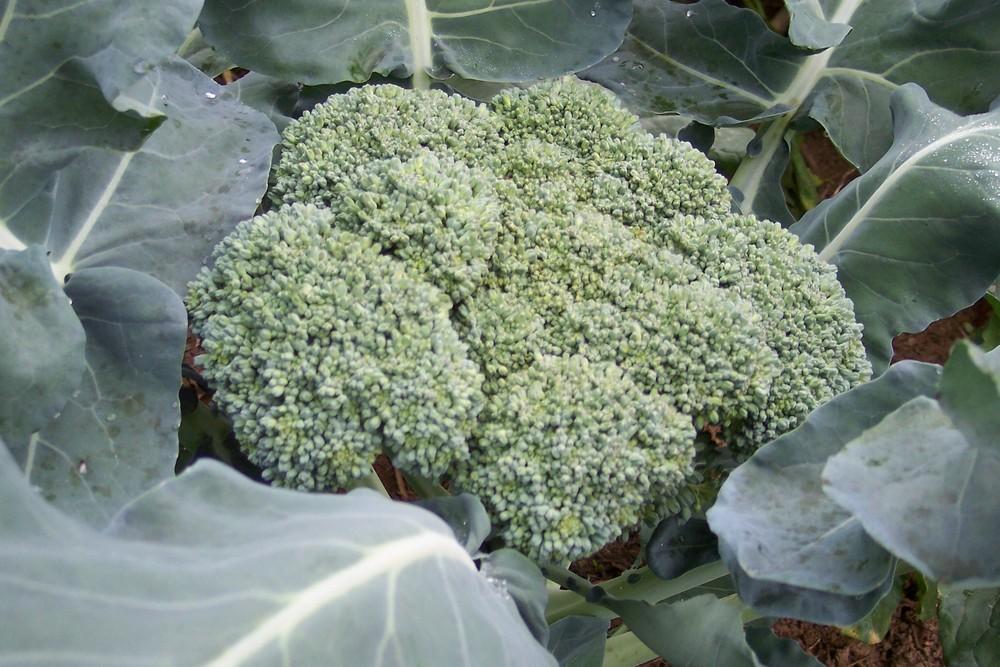
Once a seed sprouts, it sends down the start of its taproot while the stem and first leaves develop. These first leaves are called seed leaves. True leaves appear next and the plant is on its way toward fulfilling its natural goal: to produce flower buds that will eventually open and give way to a seed stalk.
Cabbage and Brussels sprouts actually surround a seed case with their tightly folded leaves, forming a head. Broccoli and cauliflower heads, or "curds", are tight bunches of the buds themselves.
Once the heads have formed, they gradually loosen (unless you pick them, of course) to make room for the seed stalk to develop. This loosening action is triggered under certain temperature, daylight and growing conditions, causing the plant to bolt, or go to seed.
The bluish green mature heads of broccoli can be harvested from early summer to late fall, depending on your climate and growing conditions. Once the first large head is harvested, most broccoli varieties produce smaller side, or lateral, shoots that extend the harvest for weeks.
In the North, plant broccoli in the early spring and again in midsummer for a fall harvest. The only time the plants won't produce heads is during the hottest weeks of summer. Your fall crop, however, will keep bearing shoots after the rest of your garden is spent. In the South, plant in late winter for an early summer harvest or early fall for winter harvesting. In warmer areas, you might want to try overwintering broccoli varieties.
Growing Brussels sprouts is almost as much fun as eating them. They start out looking just like cabbage or broccoli, but as they grow, the stems become tall and thick and sprouts pop out above each large leaf along the main stems. They look like miniature palm trees. You add to this look by breaking off the lower leaves once the harvest begins. The stems can end up two to three feet high, loaded with sprouts.
This vegetable originated in Brussels, Belgium, and is still extremely popular in Europe. As more Americans try them, Brussels sprouts are becoming better known and enjoyed in this country, too.
Cabbages can be either early, for spring planting, midseason, for planting anytime, or late for a fall crop. One thing to remember is that the late varieties need a longer growing season than the others, so you may end up planting your fall harvest earlier than a midseason variety. Check the seed packet for the days to maturity. Count back from the time you'd like to begin harvesting, and you'll have a handy planting and harvesting timetable.
Because cabbages are biennial plants (meaning they naturally take two years to produce seed), you don't have to worry about them going to seed in the garden. The main problem that gardeners have with cabbages is splitting heads, or no heads at all, which can caused by numerous reasons but usually it's temperature related. Cabbages want to grow below 80°F so don't wait too long to plant them in the spring.
Cauliflower can be used in any recipe that calls for broccoli, or served raw with dips or in salads. Kids will often eat vegetables raw that they refuse to eat cooked. That's fine, because raw veggies have more nutrients in them than cooked ones, and are easier for you to prepare.
Unlike broccoli, cauliflower produces only one head per plant. The head is called the "curd" and your only concern is to keep light away from it as soon as it's three to four inches across. After that, it's just harvest and enjoy. It freezes well, so be sure to plant enough.
'Snow Crown' and 'Early Snowball' are both popular strains of early cauliflower, reaching maturity in 50 to 60 days. Both are white, self-blanching types and are heat tolerant, so will do well in the South.
'Graffiti' is an unusual cauliflower variety that doesn't need blanching. The head matures in 80 to 85 days, and it really is purple. It turns light purple when you cook it and is an interesting variety for freezing or pickling.
The leaves of this vegetable form a loose, oblong head that grows 18 to 20 inches tall. It's sometimes called -- celery cabbage -- because it also resembles the tall, ribbed stalks of celery.
The flavor of Chinese cabbage is much sweeter than standard cabbage, with a nice nut-like aftertaste. The leaves are crisp and tender and can be used in any combination salad or stir-fry dish.
'Mei Qing Choi' (40 days). Compact and highly attractive, it grows fast and has unique green petioles (the stalk that joins the leaf to the stem).
'Jade Pagoda' (72 days). A hybrid Michihili type that grows 16" tall and produces slow-bolting, creamy yellow hearts.
Kohlrabi is started from seed in the garden for both early spring and fall crops. The plants are very hardy, and will thrive in just about any kind of soil. Just be sure to time your spring planting so it matures before the temperatures reach above 80°F, or the globes will be woody or unpleasantly pungent. Kohlrabi is the one garden vegetable that seems to be insect and disease free, making it a popular plant!
Peeled and sliced, kohlrabi makes an excellent addition to the summer crudités and dip tray. It's also delicious lightly steamed, and lends itself well to stir-fries and soups.
The two most common kohlrabi varieties are 'Early White Vienna' (it's really pale green in color) and 'Early Purple Vienna', whose skin is bright purple and looks jazzy in the garden. Both plants mature in 50 to 60 days.